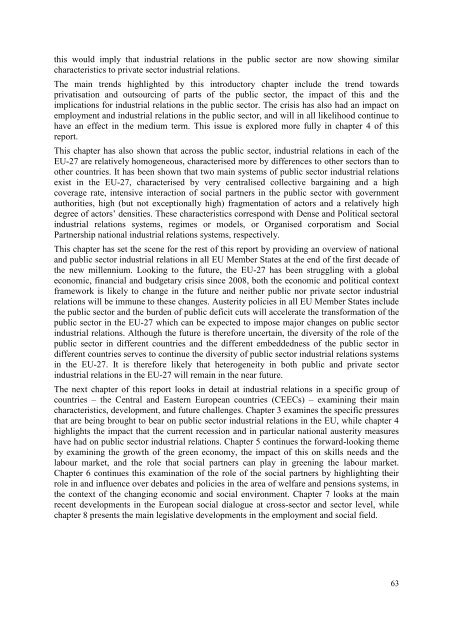Industrial Relations in Europe 2012 - European Commission - Europa
Industrial Relations in Europe 2012 - European Commission - Europa
Industrial Relations in Europe 2012 - European Commission - Europa
Create successful ePaper yourself
Turn your PDF publications into a flip-book with our unique Google optimized e-Paper software.
this would imply that <strong>in</strong>dustrial relations <strong>in</strong> the public sector are now show<strong>in</strong>g similar<br />
characteristics to private sector <strong>in</strong>dustrial relations.<br />
The ma<strong>in</strong> trends highlighted by this <strong>in</strong>troductory chapter <strong>in</strong>clude the trend towards<br />
privatisation and outsourc<strong>in</strong>g of parts of the public sector, the impact of this and the<br />
implications for <strong>in</strong>dustrial relations <strong>in</strong> the public sector. The crisis has also had an impact on<br />
employment and <strong>in</strong>dustrial relations <strong>in</strong> the public sector, and will <strong>in</strong> all likelihood cont<strong>in</strong>ue to<br />
have an effect <strong>in</strong> the medium term. This issue is explored more fully <strong>in</strong> chapter 4 of this<br />
report.<br />
This chapter has also shown that across the public sector, <strong>in</strong>dustrial relations <strong>in</strong> each of the<br />
EU-27 are relatively homogeneous, characterised more by differences to other sectors than to<br />
other countries. It has been shown that two ma<strong>in</strong> systems of public sector <strong>in</strong>dustrial relations<br />
exist <strong>in</strong> the EU-27, characterised by very centralised collective barga<strong>in</strong><strong>in</strong>g and a high<br />
coverage rate, <strong>in</strong>tensive <strong>in</strong>teraction of social partners <strong>in</strong> the public sector with government<br />
authorities, high (but not exceptionally high) fragmentation of actors and a relatively high<br />
degree of actors’ densities. These characteristics correspond with Dense and Political sectoral<br />
<strong>in</strong>dustrial relations systems, regimes or models, or Organised corporatism and Social<br />
Partnership national <strong>in</strong>dustrial relations systems, respectively.<br />
This chapter has set the scene for the rest of this report by provid<strong>in</strong>g an overview of national<br />
and public sector <strong>in</strong>dustrial relations <strong>in</strong> all EU Member States at the end of the first decade of<br />
the new millennium. Look<strong>in</strong>g to the future, the EU-27 has been struggl<strong>in</strong>g with a global<br />
economic, f<strong>in</strong>ancial and budgetary crisis s<strong>in</strong>ce 2008, both the economic and political context<br />
framework is likely to change <strong>in</strong> the future and neither public nor private sector <strong>in</strong>dustrial<br />
relations will be immune to these changes. Austerity policies <strong>in</strong> all EU Member States <strong>in</strong>clude<br />
the public sector and the burden of public deficit cuts will accelerate the transformation of the<br />
public sector <strong>in</strong> the EU-27 which can be expected to impose major changes on public sector<br />
<strong>in</strong>dustrial relations. Although the future is therefore uncerta<strong>in</strong>, the diversity of the role of the<br />
public sector <strong>in</strong> different countries and the different embeddedness of the public sector <strong>in</strong><br />
different countries serves to cont<strong>in</strong>ue the diversity of public sector <strong>in</strong>dustrial relations systems<br />
<strong>in</strong> the EU-27. It is therefore likely that heterogeneity <strong>in</strong> both public and private sector<br />
<strong>in</strong>dustrial relations <strong>in</strong> the EU-27 will rema<strong>in</strong> <strong>in</strong> the near future.<br />
The next chapter of this report looks <strong>in</strong> detail at <strong>in</strong>dustrial relations <strong>in</strong> a specific group of<br />
countries – the Central and Eastern <strong>Europe</strong>an countries (CEECs) – exam<strong>in</strong><strong>in</strong>g their ma<strong>in</strong><br />
characteristics, development, and future challenges. Chapter 3 exam<strong>in</strong>es the specific pressures<br />
that are be<strong>in</strong>g brought to bear on public sector <strong>in</strong>dustrial relations <strong>in</strong> the EU, while chapter 4<br />
highlights the impact that the current recession and <strong>in</strong> particular national austerity measures<br />
have had on public sector <strong>in</strong>dustrial relations. Chapter 5 cont<strong>in</strong>ues the forward-look<strong>in</strong>g theme<br />
by exam<strong>in</strong><strong>in</strong>g the growth of the green economy, the impact of this on skills needs and the<br />
labour market, and the role that social partners can play <strong>in</strong> green<strong>in</strong>g the labour market.<br />
Chapter 6 cont<strong>in</strong>ues this exam<strong>in</strong>ation of the role of the social partners by highlight<strong>in</strong>g their<br />
role <strong>in</strong> and <strong>in</strong>fluence over debates and policies <strong>in</strong> the area of welfare and pensions systems, <strong>in</strong><br />
the context of the chang<strong>in</strong>g economic and social environment. Chapter 7 looks at the ma<strong>in</strong><br />
recent developments <strong>in</strong> the <strong>Europe</strong>an social dialogue at cross-sector and sector level, while<br />
chapter 8 presents the ma<strong>in</strong> legislative developments <strong>in</strong> the employment and social field.<br />
63

















